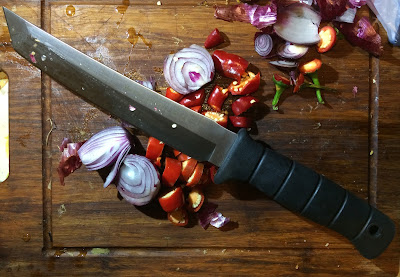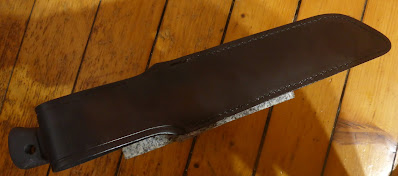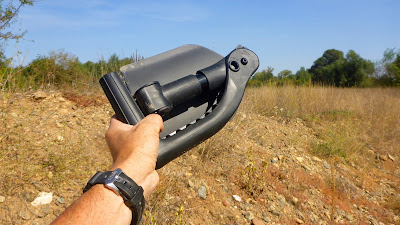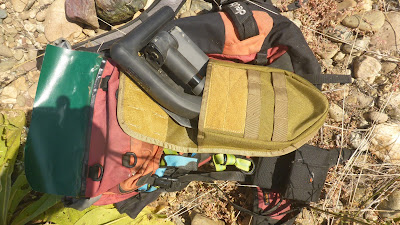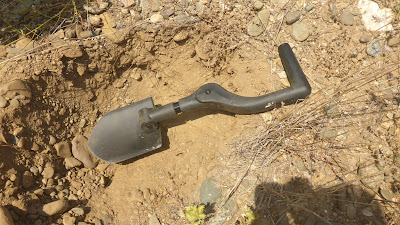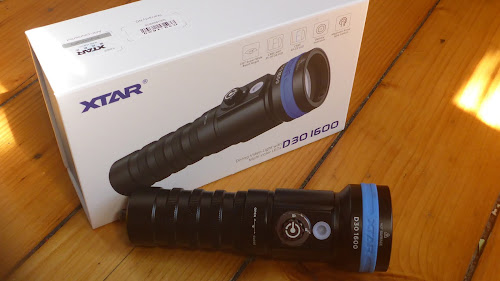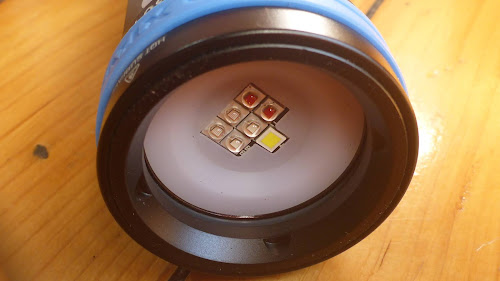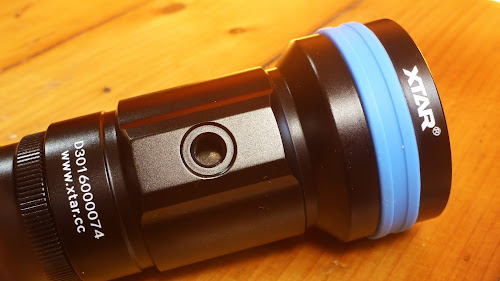XTAR D30 1600 SCUBA DIVERS VIDEO LIGHT (P)REVIEW New release!
XTAR D30 1600 Depth Rating
The internals are kept water tight to 100m via 2 O-rings (the D30 1600 came well greased on these O-rings). The operation manual suggests NOT to remove the grease from the head of the torch and I would totally agree here.
The small white colored piece of plastic above the on/off switch is an indicator of remaining battery power. 35% and above this will light green and stay on. When battery power is between 10% and 35% a RED light will be shown and less than 10% the RED light will flicker (meaning, get charging that battery asap!).
Note whilst this torch/video light can operate from many different batteries, XTAR does not recommend one does this with the lower capacity batteries such as the CR123A (X2) and (X2) 16340 batteries. (ok for 18650's, 18700's, 26650's)

Basic operation of the XTAR D30 1600
The switching mechanism is of professional design meaning it is a "magnetic switch" which means there is zero contact between the switching mechanism and the inner workings. This type of switch for an underwater dive torch/video light is IMHO the best type as it reduces the need for unnecessary seals.
The image above shows the switch in the "Locked" position to prevent accidental operation. Turning the switch clockwise past a small indent, will put the switch in a pre operation mode. One press at this point will automatically operate the D301600 at it's maximum capacity of 1600 lumens (for up to 2 hours if using a fully charged 26650 high capacity Li-ion battery). The D30 1600 comes with a 26650 XTAR branded battery, a XTAR USB multifunction charger, an adaptor tube-because the D30 1600 can run from 18650 batteries as well, however at reduced capacity.

The first press activates 1600 Lumens of white light, second press activates 800 lumens for an estimated run time of 3.2 hours. For the second setting, the light can easily operate for 15 minutes in an ambient temperature of 25C, without overheating. The body just becomes slightly warm. Remember this is an UW video light and meant to be specifically used whilst submerged. However, clearly one can use this light above water on the lower settings of the white light. Finally a 3rd press activates the low power mode of 400 Lumens and a run time of approximately 6.6 hours according to XTAR; In this final white light mode the video dive light can easily operate at room temperature without overheating. The actual body of the torch is quite a large mass of aluminium and it acts as a good heat sink.

To enter into the colored modes, switch off the light and then press twice for the RED setting of 260 lumens and then press again to enter the Blue light mode of 130 Lumens, followed by a another press to enter the (unfiltered) UV mode of approximately 6watts of power. The colored modes have a maximum continuous duration of approximately 3.3 hours.
The front port of the XTAR D30 1600 is optically coated for maximum transmission.
It should be noted that the D30 1600 Diver's video light will consume battery power even whilst the light is switched off, so if the light was not to be used for a while, then one should remove the battery and keep it charged.
There are a total of 7 LEDs in the XTAR D30 1600.
The full spectrum light is from one CREE XHP 35 HI D4 LED. The remaining 6 LEDS are CREE XP E2 LEDs.
Since this is a video light, there is an absence of a traditional type parabolic reflector and instead, the D30 1600 features a special white "reflective surface" this surface aids in producing a extremely even wide spread beam of light in order not to produce any "hotspots" or "dark areas" but essentially very even lighting, in both intensity and distribution.
The XTAR D30 1600 Diver's video light features a standard 1/4" 20 tripod mount to attach a ball and socket head
Build quality
The overall build quality looks good and the torch/video light has a very solid feel to it. Unlike many other branded diving/underwater/video lights, the XTAR D30 1600 comes with a lanyard, 26650 battery and a portable USB charger all in a sturdy magnetic catch lid box; with good instructions.
For the forgetful there is even marking upon the housing to indicate which way to secure the torch casing.
A blue rubber head bumper is present although I feel this offers little real protection due to it sitting almost flush with the video light's body.
Continuous operation of the XTAR D30 1600
Needless to mention (but I do anyway), this light is NOT meant as some tactical light or regular flashlight and due to it's sheer power should only be continuously operated whilst underwater.
Maintenance
Keep the torch clean and free of salt encrustations (in other words wash it thoroughly after diving-like the rest of your kit!)
Keep the batteries fully charged and use the adaptor when using 18650 type batteries.
With the exception of the 2 O-rings (and charging batteries), there are no user serviceable parts within this Video light.
Like all dive equipment keep it clean and one will obtain a long service life (in other words don't get the O-rings dirty. NEVER use any sharp or even blunt metal object to remove the O-rings when changing them out.
What about the UV? What Wavelength is it?
The 6W UV LED (medium wave, actual wavelength is not stated, however my experience tells me it is above 365nm (true long wave) is more than powerful enough to cause excitation of mineral samples, man made fluorescent objects and other naturally occurring biological materials. This should be good for videography of certain coral species. We will be looking at fluorescence with a large cave system.
What's in the box for the XTAR D30 1600?
Manuals for light an USB battery charger. Included (one) XTAR 26650 Li-ion battery, battery adaptor for 18650 type and other batteries (see manual for instructions). A wrist lanyard, USB cable(not shown here). Personally, I would have liked to have seen included a front port protective cap to stop it getting scratched, so I recommend that the XTAR video light be transported separately from other dive gear.The operational instructions are in only English and Chinese.
The supplied battery charger, whilst electrically capable of charging a 26650 battery, the dimensions of the 26650 battery will just barely make electrical contact with the positive charing terminal and tends to rise up due to the spring loading of the terminals. A quick fix to make sure proper contact is achieved during charging is to put an elastic band around the battery and charger.
However this being said, the charger works just fine and this is the 3rd type of charger I own from XTAR and they work very well (My oldest charger now over 3 years and still going strong after several passages around the globe with it).
Electrical contact is made, although only via a small surface area of contact.
The supplied XTAR MC1 Plus charger is a "Smart Charger" and can charge at either 1A or 0.5 Amps. Here we see it charging at 1A as I have it connected to a 2.1A supply (large 18650 power bank with 2 outputs, 1.5A and 2A outlets).
Where will my XTAR D30 1600 get used?
So soon, the D30 1600 will form part of an under water lighting system on caving trip where we will use this light to place some underwater 4k cameras into an underground lake! So stay tuned...!
Breaking news! Part one video filed test now complete!
BCT



